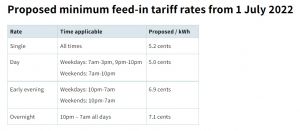Victorians with solar panels could soon earn less for exporting electricity, following the regulator’s proposal of dropping the minimum feed-in tariff (FiT) from 1 July 2022.
The proposed minimum feed-in tariff for 2022-23 is 5.2 cents per kilowatt hour (kWh) for households on a single rate tariff – dropping from its current rate of 6.7c/kWh.
Time varying solar feed-in tariffs are also expected to decrease, from 6.1c-10.9c/kWh to 5c-7.1c/kWh, depending on the time of day.
See below for the Essential Services Commission’s (ESC) proposed changes to solar feed-in tariffs in Victoria.

Source: Essential Services Commission, Solar Value Remains Despite Falling Feed-in Tariff, December 2021.
Falling wholesale power prices over the past two years has led the commission to revisit the minimum FiT rate, although retailers can offer more, ESC pricing director Marcus Crudden explained.
“We encourage customers to shop around when deciding on a retailer offering feed-in tariff rates and to consider their energy consumption and generation,” he said.
The ESC noted the proposed decrease was largely driven by cheaper wholesale costs which make up about two-thirds of a feed-in tariff.
Though household returns on solar exports may be getting less attractive, solar is still a worthy investment for consumers, Mr Crudden added.
“The real and enduring value of renewable generation and storage is in not having to pay retail electricity charges for the electricity you use,” he said.
“The latest data shows participants in Victoria’s Home Solar Program are saving an average of $1,073 on their annual power bills while making a major contribution to reducing emissions.”
The Victorian Home Solar Program is a government-led initiative that provides rebates for the installation of solar products, such as panel systems, batteries and hot water systems, to eligible homeowners and renters in the state.
The draft decision is open for consultation until 10 January 2022, and if approved, will come into effect from 1 July 2022.
Compare Solar Plans Victoria
While a minimum feed-in tariff is on offer in Victoria, some energy providers will throw in a higher solar FiT rate than the market average. Here are some of those deals.
Here are some of the cheapest solar-specific deals from the retailers on our database. These costs are based on the Citipower network in Melbourne but prices will vary depending on your circumstances. We show one product per retailer, listed in order of lowest price first. Annual price estimates assume general energy usage of 4000kWh/year for a residential customer on a single rate tariff. Price estimates exclude solar feed-in tariff credits. These are products from referral partners†. Our database may not cover all deals in your area, and please check retailer websites for up to date information.
Have solar feed-in tariffs dropped in Victoria recently?
Yes, according to recent Canstar Blue research, the average solar feed-in tariff on single rate plans across Victoria had fallen by roughly 3.3c/kWh from January to October 2021. This means the average FiT rate now sits at around 7.6c/kWh, only slightly above the state’s current minimum of 6.7c/kWh.
Despite the minimum FiT rate trending downwards, some retailers may continue offering a higher rate. Just be mindful however, that a higher feed-in tariff may come with some strings attached, or it may be concealing higher electricity usage and supply charges.
At the time of publication, the highest solar feed-in tariff in Victoria for households on a single rate tariff is 12c/kWh, though conditions apply.

Image credit: Trong Nguyen/Shutterstock.com, Essential Services Commission.

Share this article